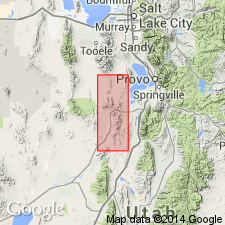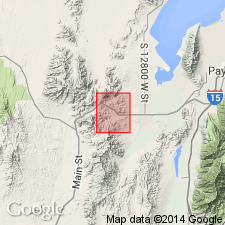
- Usage in publication:
-
- Laguna Springs latite*
- Modifications:
-
- Named
- Dominant lithology:
-
- Latite
- Agglomerate
- AAPG geologic province:
-
- Wasatch uplift
Summary:
Named for exposures near Laguna Springs in lower part of canyon of Pinyon Peak in W1/2 NW1/4 sec 32, T9S, R2W, Utah Co, UT on Wasatch uplift; these exposures designated type locality. Consists of latite effusives that have a wide range of textures, that are similar in mineralogic composition and that are thought to be the product of one series of volcanic eruptions. Divisible into: 1) basal tuff, fine to coarse grained that is locally an agglomerate of rhyolite, andesite, quartzite, limestone, and shale fragments; 2) lower flow series of dark red, gray or black, coarsely porphyritic rocks that are 10 to 30 percent orthoclase, plagioclase, hornblende, biotite, augite, magnetite and quartz phenocrysts; 3) intermediate tuff and agglomerate unit that is coarse grained, bedded, not resistant to erosion; 4) upper flow series that can be separated from the lower flow series if the intervening unit is present; and 5) agglomerate the most widespread unit, a heterogeneous assemblage of angular to subround fragments of poorly stratified fragments. Thickness not given. Disconformably overlies Packard quartz latite. Considered middle Eocene. Geologic map.
Source: GNU records (USGS DDS-6; Denver GNULEX).

- Usage in publication:
-
- Laguna Springs Volcanic Group*
- Modifications:
-
- Revised
- AAPG geologic province:
-
- Wasatch uplift
Summary:
Revised--rank raised to Volcanic Group and divided into 3 formations whose type areas are all near Laguna Springs in north-central part East Tintic district, Utah Co, UT on Wasatch uplift. No type locality designated for group. Ranges to as much as 2,100 ft thick. Divided into (ascending): 1) North Standard Latite, composed of a basal, heterogeneous boulder tuff member overlain by a medium-grained latite vitrophyre flow member; 2) Pinyon Queen Latite, composed of a lower tuff member of intermixed fine-grained and boulder tuff and agglomerate, and an upper flow member of medium- to coarse-grained latite porpyhry characterized by large white plagioclase phenocrysts; and 3) Tintic Delmar Latite, composed of a basal fine- to coarse-grained tuff member overlain by a flow member of medium-grained latite porphyry. Three formations are similar in chemical and mineralogical composition, and all of them contain hornblende, which distinguishes them from both Tintic Mountain Volcanic Group and Silver Shield Quartz Latite (both new). They are the extrusive equivalents of the monzonite of Silver City stock in the main Tintic district and its satellitic monzonite porphyry plutons in East Tintic district. Group overlies Big Canyon Latite (new) of Tintic Mountain Volcanic Group; underlies Pinyon Creek Conglomerate (new). Middle Oligocene age based on stratigraphic position and K-Ar dating. Geologic map, sections, and stratigraphic chart.
Source: GNU records (USGS DDS-6; Denver GNULEX).
For more information, please contact Nancy Stamm, Geologic Names Committee Secretary.
Asterisk (*) indicates published by U.S. Geological Survey authors.
"No current usage" (†) implies that a name has been abandoned or has fallen into disuse. Former usage and, if known, replacement name given in parentheses ( ).
Slash (/) indicates name conflicts with nomenclatural guidelines (CSN, 1933; ACSN, 1961, 1970; NACSN, 1983, 2005, 2021). May be explained within brackets ([ ]).

